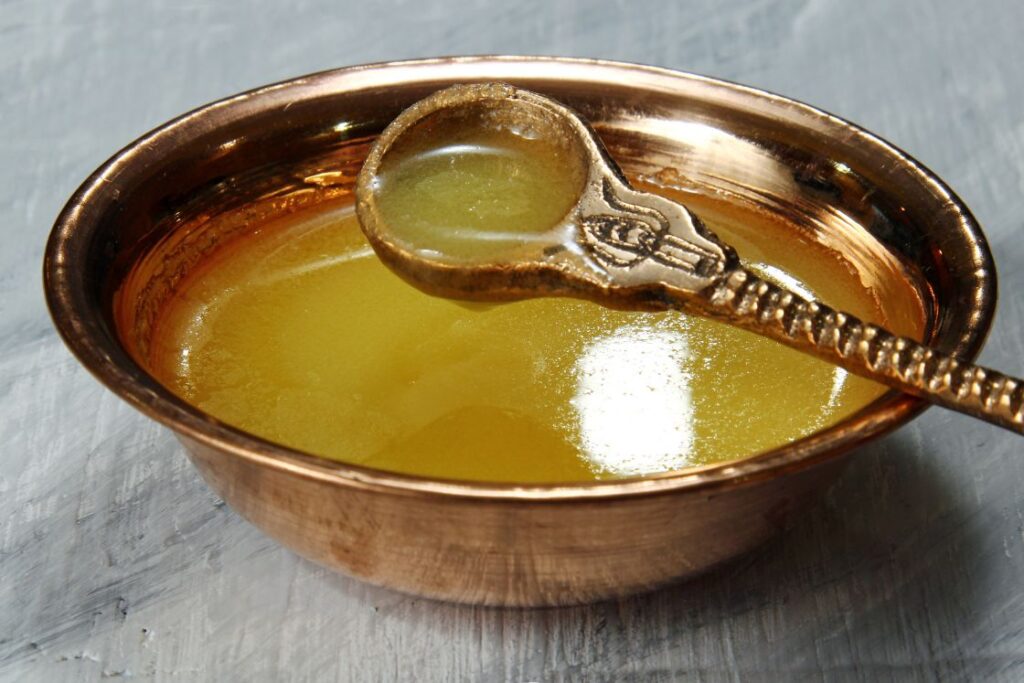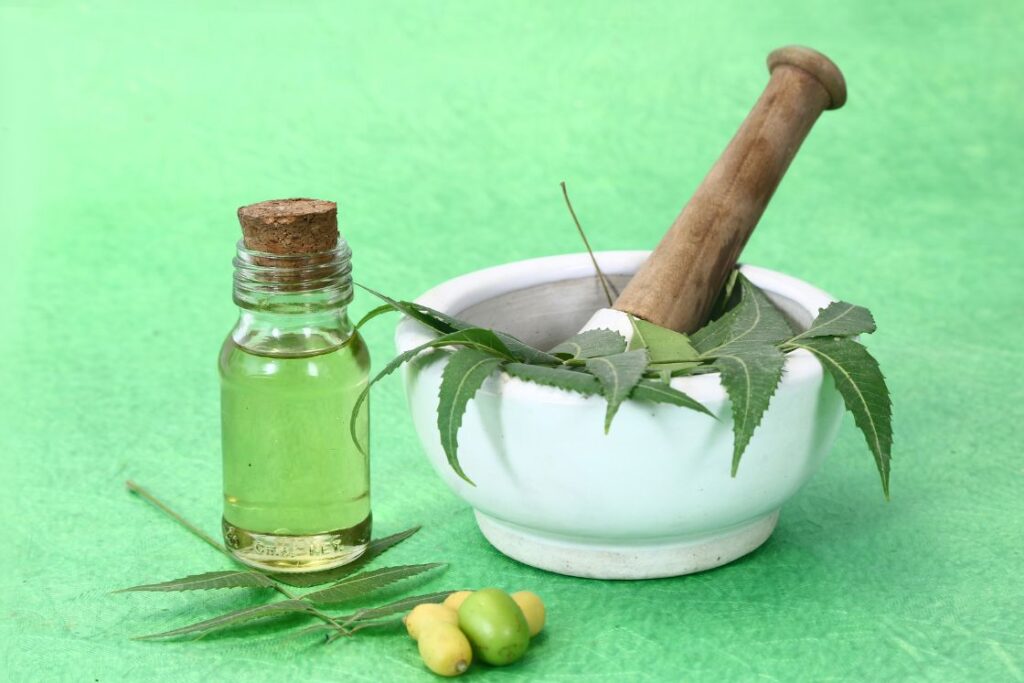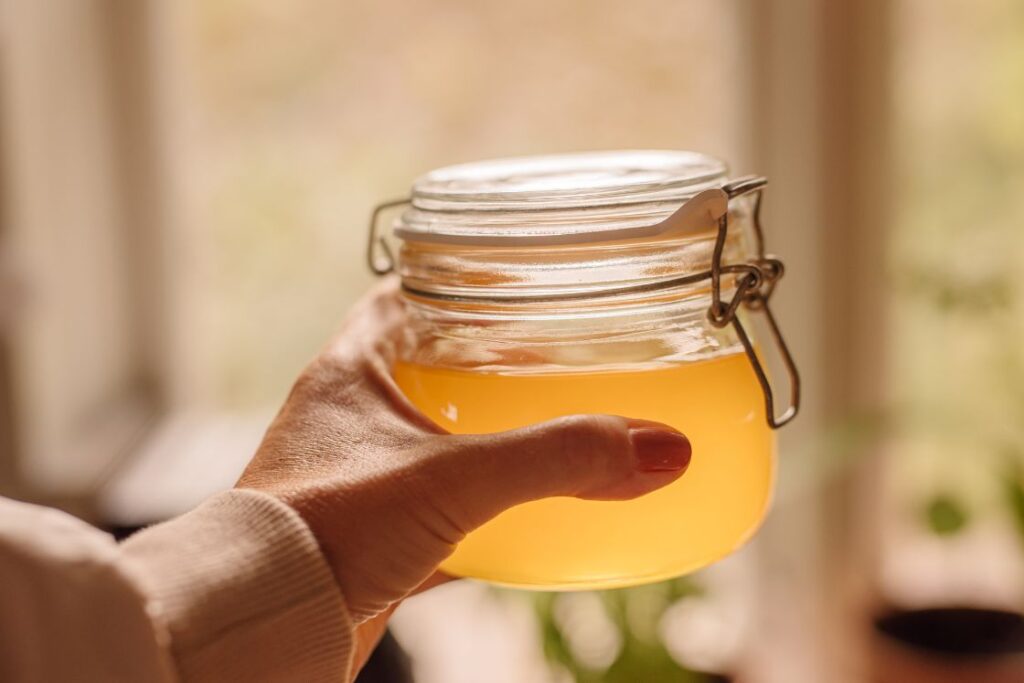- Concept
- Procedure
- Benefits
- Types of Sneha
- Dosage
- Foods to eat
- Symptoms
- Contraindications
- Precautions

Snehapana is an important therapy in Ayurveda, which involves the oral intake of medicated ghee or oil. The Sanskrit term “Sneha” refers to oil or medicated ghee, and “Pana” means ingestion, hence the name “Snehapana”. It’s done as a preparatory process for Panchakarma.
In Snehapana therapy, a specific quantity of medicated ghee or oil is consumed on an empty stomach in the morning, followed by a specific diet and lifestyle regimen. This therapy is used for both preventive and curative purposes in Ayurveda. It is believed to help improve digestion, boost immunity, enhance skin health, relieve joint pain, and improve overall health and well-being.
In this article, we will delve deeper into the concept of Snehapana in Ayurveda, its benefits, how it is performed, and the precautions that need to be taken while undergoing this therapy. We will also explore the different types of medicated ghee or oil used in Snehapana and their therapeutic benefits. So, let’s get started and explore the world of Snehapana in Ayurveda.
Concept of Snehapana in Ayurveda

Ayurveda is a holistic system of practices that emphasizes the importance of balance between the three doshas: Vata, Pitta, and Kapha. Any imbalance in these doshas can lead to various health problems. Snehapana is a therapy that is used in Ayurveda to balance the Vata dosha.
Snehapana is an internal oleation therapy, which involves the consumption of medicated ghee (clarified butter) or oil to lubricate the internal organs and tissues. The concept of internal oleation therapy is based on the principle that oil can penetrate the body tissues and transport the healing properties of herbs and minerals to the deeper tissues.
In Ayurveda, the elimination of toxins from the body is achieved through a process called Panchakarma, which involves a series of therapies that aim to remove toxins and impurities from the body. Panchakarma includes mainly 5 therapies
- Vamana (emesis therapy)
- Virechana (purgation therapy)
- Basti (enema therapy)
- Nasya (nasal administration of medicine)
- Raktamokshana (bloodletting therapy).
Snehapana in Ayurveda is a preparatory therapy that is often performed before main Panchakarma therapy to help loosen toxins and prepare the body for elimination. It particularly enhances the treatments of Vamanamm (emesis therapy) and Virechanam (purgation therapy) therapies.
The use of Snehapana is to prepare the body for the process of expelling toxins. It ensures that the body’s cells are soaked with enough oil to the point where they are set to evacuate it all at the earliest opportunity. It helps to flush out toxins from the body by lubricating the digestive tract and increasing the efficiency of the elimination process.
How Snehapana Helps in Balancing the Doshas?
In Ayurveda, the Vata dosha is responsible mainly for movement. It is associated with dryness, coldness, and roughness. When the Vata dosha is imbalanced, it can lead to various health problems such as constipation, dry skin, joint pain, anxiety, and insomnia. Snehapana is used to balance the Vata dosha by providing lubrication to the body tissues and calming the nervous system.
Snehapana helps treat a variety of illnesses, including arthritis, urinary issues, psoriasis, and gastroenterological ailments like peptic ulcers, indigestion, bowel issues, constipation, and diarrhoea.
Patients undergoing this treatment are given medicinal ghee prepared from cow milk (or, in certain cases, medicinal oil), which must be ingested orally on an empty stomach. The medicated oil or ghee is continuously consumed until it begins to seep out of your pores.
How Snehapana is done?

Snehapana is a therapeutic procedure. It involves consultation with a qualified Ayurvedic practitioner who assesses your overall health, determines your Dosha (body constitution), and prescribes the appropriate type and quantity of medicated ghee or oil for you.
Here is the step-by-step procedure for Snehapana treatment:
- Patient Assessment: The treatment is done under the supervision of a trained and qualified Ayurvedic doctor/practitioner. The doctor observes the general condition of the patient, the ailment for which the treatment is being used, and other factors like medical history, habits, addictions, and general lifestyle of the patient.
- Determination of Medicinal Ghee/Oil Quantity: The doctor determines the quantity of medicinal ghee/oil to be consumed by the patient based on the patient’s condition and the intended therapeutic outcome.
- Preparatory Phase: The patient is asked to take a moderate amount of warm, liquid foods one day before the ghee consumption to prepare the body for the treatment.
- Lukewarm Ghee/Oil Consumption: The medicinal ghee/oil is heated to a lukewarm temperature and given to the patient on an empty stomach, usually in the morning hours. The patient is asked to sit comfortably on a chair while consuming the ghee/oil.
- Observation and Monitoring: After the patient drinks the ghee/oil, the doctor monitors for signs of complete digestion, which helps determine the time needed for the ghee/oil to be digested and assimilated into the body.
- Daily Consumption: The ghee/oil is consumed once every day by the patient for the entire course of the treatment, as prescribed by the doctor.
- Treatment Cessation: Once there are signs of improved bodily functions, the treatment is stopped by the doctor.
Generally, Snehapana therapy can last for 3 days to 2 weeks, with the frequency and duration of the therapy being determined by the Ayurvedic practitioner based on the unique diagnosis, physiology and needs of the individual undergoing the treatment. During this duration, the medicinal ghee has to be consumed once each day and the quantity will be decided as per the digestive ability of the patient.
To determine how long it will take for the patient to digest the ghee, the doctor will look for symptoms of complete digestion after the patient has consumed it. The Sneha has been entirely digested if there is no sneha odour in belching.
The above procedure is known as Achapana or Acchapeya Snehana which comes under internal oleation therapy or abhyanthara snehana.
Another form of Snehapana is bahya snehana wherein oleation is carried out through various ayurvedic massages such as Shirodhara, Abhyanga, etc.
Quite often, you might be asked to go through Swedana which is an ayurvedic detox therapy for encouraging the release of sweat. You are also given massages regularly to release the toxins on the muscles and stimulate the lymphatic system.
Benefits of Snehapana Therapy
Snehapana is quite well-known therapy in Ayurveda for detoxification due to its process of eliminating toxins from the digestive tract, blood cells, and GI tract. By removing the toxins, you are essentially setting up your body to get nourished from fresh blood, stimulating the digestive and elimination process, and making sure that your doshas morbidities are minimized.
Owing to the above, here are some benefits of undergoing Snehapana therapy:
- Improves the efficacy of digestion and stimulates the digestive agni.
- Nurture your body’s tissues.
- Controls metabolism and lessens interior dryness.
- Internal body cleansing helps to prevent chronic diseases.
- Improves health and enhances immunity.
- Makes the skin soft and reduces ageing symptoms including wrinkles and loss of skin suppleness.
- Minimizes the stress and anxiety resulting from a competitive and fast-paced life.
- Aids in weight loss by saturating the body with additional fat from the ghee, which prompts them to expel the excess fat along with any toxins that may have been present.
Types of Sneha used in Snehapana

Generally, 4 types of Sneha are used in Snehapana therapy: ghee, sesame oil, animal fat, and bone marrow. Out of these, ghee is the most preferable as it is compatible with all the doshas, easily digestible, doesn’t cause a burning sensation, and complements the other substances that you consume.
The time of year that a patient receives treatment affects which sneha substances they should consume. Ghee has been suggested for the fall, using oil is favoured in the winter, and using fat and bone marrow has been suggested for the spring.
Since bone marrow is the hardest and heaviest substance to digest, you may not find many ayurvedic practitioners using this for snehapanam.
Dosage and frequency
The ideal duration for snehapana is 3-7 days, with the quantity of ghee proportionately increasing each day. However, it also largely depends on the bodily response, physiology, and diagnosis of the patient.
The dosage of the sneha can vary from low to maximum based on the ailment of the patient or the intention of taking the procedure.
The maximum Dose is given to those who are used to consuming a lot of sugary foods regularly, can handle hunger and thirst, and have sound immune systems. The sneha is generally digested within 24 hours.
Problems like constipation, dysentery, and digestive system irritation can be considered for maximum dose.
Medium Dose is recommended for people who have medium strength, are accustomed to eating in moderate quantities, and have mild bowel patterns. The sneha is generally digested within 12 hours.
A moderate dose treats conditions including gout, obstinate urinary diseases, vesicles, itching, and rashes on the scalp.
Low Dose is recommended for those with less strength, seniors, kids, people with weaker constitutions, people who can’t handle hunger, and people with impaired digestion. The sneha is generally digested within 6 hours.
Unctuousness in a lower dosage is advised in cases of chronic illnesses including fever, diarrhoea, and cough.
Another classification is a very light dose or a test dose. The Sneha consumed here can be digested as soon as 3 hours. This is generally prescribed to test an individual’s digestive capacity and gut. Based on this test dose, further treatment plans and dosage will be decided.
Food to eat during Snehapanam
Throughout all days of Snehapana treatment, you will only be consuming warm foods only when you feel hungry. There is no designated meal time so if you feel hungry at midnight, you are allowed to eat.
Make sure that whatever you eat is light such as rice congee, soup, or porridge. It should not have too many ingredients, not be too oily, and must be liquified to a certain extent.
Moreover, you should drink water only in sips throughout the day instead of a full glass. And it should be warm instead of room temperature or cold.
You must enquire about the foods you should eat with your ayurvedic practitioner.
Symptoms of Snehapanam
People rarely experience any negative effects from this Snehapana.
However, in response to the intake of ghee, indigestion may arise in some patients, which could lead to burping, belching, and flatulence as a symptom. Furthermore, headaches, nausea, and vomiting could occur.
Rarely, low energy and mood swings are noticed when receiving the ghee in Snehapana therapy. This occurs as a result of your body going through a thorough cleansing process. By practising solitude, engaging in meditation, getting plenty of rest, or reading inspiring literature, mood fluctuations can be controlled.
It is also normal to experience the urge to throw up or experience loose stools. A piece of lemon will be offered for sucking in this situation, which will aid to lessen the unpleasantness.
Contraindications of Snehapana
While Snehapana is considered safe and effective when performed under the guidance of a qualified Ayurvedic doctor, there are some contraindications to keep in mind. The following conditions or situations may prevent a person from undergoing Snehapana therapy or require special precautions:
- Pregnancy or breastfeeding: Snehapana is not recommended for pregnant or breastfeeding women.
- Obesity: Patients with excessive weight should avoid Snehapana therapy as it may increase their weight further.
- Diabetes: Snehapana may cause an increase in blood sugar levels, so patients with diabetes should avoid this therapy.
- Liver disorders: Patients with liver disorders such as cirrhosis or hepatitis should avoid Snehapana therapy.
- Cardiovascular disorders: Patients with heart disease or high blood pressure should undergo Snehapana therapy only under close medical supervision.
- Kidney disorders: Patients with kidney disease should avoid Snehapana therapy.
- Asthma: Patients with asthma should avoid Snehapana therapy as it may trigger breathing difficulties.
- Menstruation: Snehapana is not recommended during menstruation as it may cause discomfort and other complications.
Precautions to take during and after the procedure
The below precautions should be strictly adhered to throughout the procedure and even for a few days after the completion. This is to ensure that you get the maximum benefit of snehapanam.
- Use only hot or warm water for all purposes such as drinking, bathing, or even while going to relieve yourself in the toilet.
- Make sure you are curbing the natural urge to urinate and defecate.
- Do not perform any strenuous activity or exercise.
- Sleeping during the day is prohibited.
- Your diet should only include warm liquid or sweet foods. Raw fruits and vegetables, sour foods, fast foods, or any form of stimulant are to be strictly avoided.
- Abstain from all sexual activities for the duration of the procedure.
- Make sure you protect yourself from cold, sun, breeze, wind, dust, and smoke. Keep yourself covered if you have to go out.
- Avoid engaging in activities that sap your energy, such as talking loudly, swimming, long-distance walks, fights, losing your temper, worrying excessively, and using electronic devices like laptops, tablets, and mobile phones.
Conclusion
In Ayurveda’s Panchakarma therapy, snehapanam is a crucial procedure. Before beginning additional Ayurvedic treatments, Snehapanam is administered to nourish every bodily component. It is a method of internal oleation with either plain or medicated ghee depending on the patient’s circumstances.
This procedure is essential because it loosens the toxins and Doshas in the body, making it easier for them to be expelled during the first stage of treatment. To track improvement and modify the treatment strategy, frequent follow-up sessions with the Ayurvedic practitioner are also required.
By flushing out toxins deeply from the body, it removes the root cause of many problems and paves the way for better immunity, metabolism, and overall better health.




